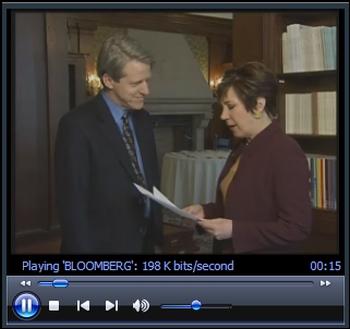World Economies Face Perfect Storm of Deepening Recession and Banking Crisis
Economics / Recession 2008 - 2010 Feb 22, 2009 - 08:34 AM GMT A perfect storm of a deepening global recession and banking woes last week battered equities and supported the safe havens of the US dollar, government bonds and gold bullion.
A perfect storm of a deepening global recession and banking woes last week battered equities and supported the safe havens of the US dollar, government bonds and gold bullion.
A dismal corporate earnings outlook, fears about bank nationalizations, especially Bank of America (BAC) and Citigroup (C), and a warning by Moody's Investors Service of possible downgrades of European banks exposed to the slumping economies of Central and Eastern Europe, stoked investors' fears.
Few stock markets escaped the selling pressure as summarized by the week's movements of the MSCI Global Index (-7.7%, YTD -16.0%) and the MSCI Emerging Markets Index (-9.3%, YTD -11.4%). Venezuela (+6.7%), Pakistan (+6.1%) and Morocco (+3.7%) were the top three performers, whereas potential debt defaulters - Russia (-17.1%), Ukraine (-12.5%) and Hungary (‑12.4%) - occupied the bottom end of the ranking (data courtesy of Emerginvest ).
The major US indices suffered their worst weekly losses this year (to record six losing weeks out of seven): Dow Jones Industrial Index -6.2% (YTD ‑16.1%), S&P 500 Index -6.9% (YTD -14.7%), Nasdaq Composite Index ‑6.1% (YTD -8.6%) and Russell 2000 Index -8.3% (YTD -17.7%).
Negative sentiment dragged the S&P 500 to seven points below its October 2002 low, whereas the Dow stopped only 80 points short of this key level. It is noteworthy that it took five years for the latter to increase from 7,286 to 14,165, but only 16 months to wipe out the entire 2002-2007 advance.
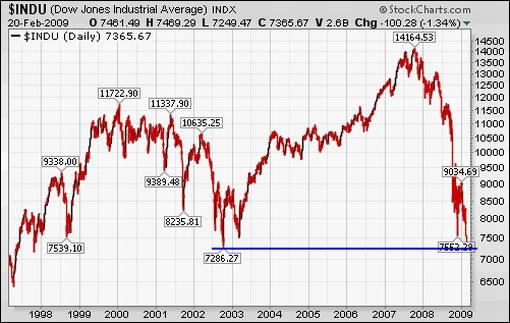
Source: StockCharts.com
With the bears prowling Wall Street, none of the main economic sectors registered positive returns on the week. Among exchange-traded funds (ETFs), the KBW Bank Index ETF (KBE) and the Financial Select Sector SPDR ETF (XLF) lost 16.6% and 15.9% respectively. However, as highlighted by John Nyaradi ( Wall Street Sector Selector ), inverse exchange-traded funds (ETFs) such as ProShares Short S&P 500 (SH) (+6.8%), ProShares Short Dow30 (DOG) (+5.8%) and Short QQQ ProShares (PSQ) (+5.1%) gained handsomely.
As was the case the previous week with the announcement of Treasury Secretary Timothy Geithner's financial stability plan , last week's mortgage relief plan, designed to stem the foreclosure crisis, also made scant impression on the stock market. President Barack Obama earmarked $275 billion to help reduce mortgage payments for up to nine million struggling borrowers and enable Fannie Mae and Freddie Mac to keep mortgage rates down.
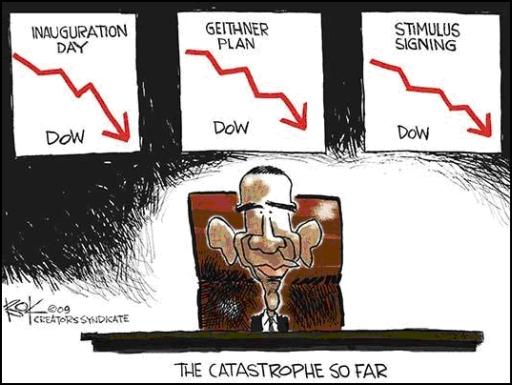
Jeff Randall ( Telegraph ) wrote: “… we are in denial about the causes of recession and therefore cannot face up to the action required to lift us out of it. As Niall Ferguson , professor of history at Harvard University, wrote: ‘The reality being repressed is that the Western world is suffering a crisis of indebtedness.' In which case, pumping out yet more debt will not be the answer. It is simply a short-term fix that in the long run creates an even bigger disaster, like giving a shivering alcoholic a case of Special Brew.” (Also read RGE Monitor's recent guest post on the US's financing needs.)
Barry Ritholtz ( The Big Picture ) has an interesting post up that lists the names of those favoring and opposing nationalization of the bigger US banks. Yes, I know it is a politically controversial issue, but rather get it over and done with than pussyfooting with “behind-the-curve” measures as being experimented with by the policymakers week after week. If nationalized banks are still alive once the toxic junk has been marked to market, they can start acting like banks and stake their claim to be privatized once again in the next economic upswing.
Notwithstanding supply concerns, government bond yields in the US, UK and Germany declined as investors continued their flight to safety. Yields of 10-year Treasuries, Bunds and Gilts were down by 14, 12 and 12 basis points respectively.
Increasing financial turbulence also resulted in the gold holdings of the world's largest bullion-backed ETF jumping to a record level. “The SPDR Gold Trust (GLD) holdings have risen by 228.6 metric tons so far this year, to a record 1,008.8 metric tons late on Tuesday, absorbing in the first seven weeks of the year about 10% of the world's annual mine gold output,” reported the Financial Times . Gold bullion breached the $1,000 level on Friday and closed the week at $1,002 (+6.4%) - within striking distance of its record of $1,031 reached in March last year.
With the yellow metal behaving like “the last man standing”, David Fuller reminded us of the quote by the English poet Lord Byron: “O gold! I still prefer thee unto paper, which makes bank credit like a bark of vapour.”
Besides precious metals shining brightly, the other commodities performed poorly, as shown in the graph below. The Reuters/Jeffries CRB Index recorded a six-and-a-half year low as global growth deteriorated.
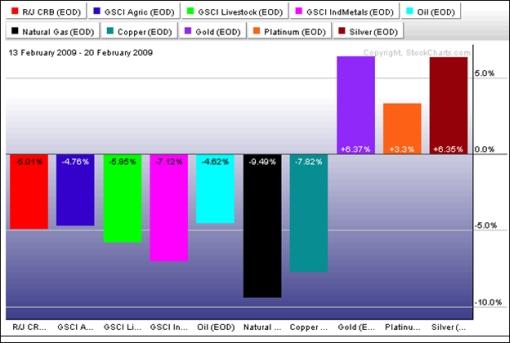
Next, a tag cloud of my week's reading. This is a way of visualizing word frequencies at a glance. Key words such as “banks”, “China”, “financial” and “gold” featured prominently .

As far as the outlook for stock markets is concerned, the primary bear market was reconfirmed on Thursday, at least in terms of Dow Theory . Richard Russell ( Dow Theory Letters ) said: “The verdict, at long last, is in. Today the DJ Industrial Average closed below its November 20 bear market low. In so doing, the Dow confirmed the prior breakdown of the Transportation Average. The two Averages jointly closed at new lows today, thereby signaling that the great bear market remains in force.
“According to Dow Theory, neither the duration nor the extent of a bear market can be predicted in advance. However there are some useful hints. Most major bear markets end with stocks at ‘great values'. This has meant in the past that price/earnings (P/E) ratios for the Dow and the S&P have fallen to single-digit numbers. It has also meant that dividend yields have moved into the 5-6% zone.”
Standard & Poor's estimated GAAP (or “as reported”) earnings of 32.3 cents for the S&P 500 for 2009 implies a ten-month prospective P/E ratio of 23.8. Hardly “great value”.
As mentioned above, the Dow and S&P 500 are floundering around the November 20, 2008 and October 2002 lows, as shown in the columns on the right-hand side of the table below.

Stock markets remain caught between the actions of central banks frantically trying to fend off a total economic meltdown on the one hand, and a worsening economic and corporate picture on the other. The next few days will tell whether the key chart levels will arrest the indices' declines and the three-month trading range will hold, or whether more catastrophe lies ahead.
For more discussion about the direction of stock markets, also see my recent posts “ Video-o-rama: Stocks between a rock and a hard place ” and “ Bennet Sedacca: Free Fallin'??? “. (And do make a point of listening to Donald Coxe's weekly webcast, which can be accessed from the sidebar of the Investment Postcards site.)
Announcement
Back to Richard Russell, 84-year old writer of the Dow Theory Letters . Business partner John Mauldin ( Thoughts from the Frontline ) is organizing a “Richard Russell Tribute Dinner” for April 4 in San Diego. This will be a night of memories and good fun with fellow writers and long-time readers of Richard's newsletter. I will be making the trip from Cape Town and would encourage you, if at all possible, also to attend this very special event. You can register here .
Economy
A grim picture regarding the global economic situation emerges from the latest Ifo World Economic Survey (WES), showing that the World Economic Climate has declined to a record low in the first quarter of 2009. The deterioration is affecting all major economic regions and the export and import expectations indicate a clear decline in world trade in the first half of 2009.
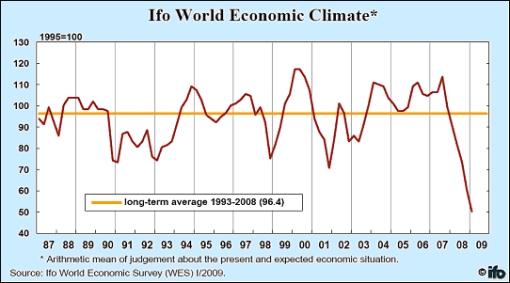
Source: Ifo , February 18, 2009.
Further evidence of the economic malaise is provided by the GDP-weighted graphs of the global manufacturing Purchasing Managers' Index and global services PMI.
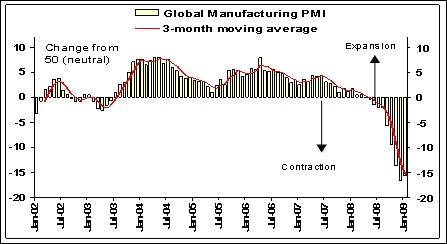
Source: Plexus Asset Management
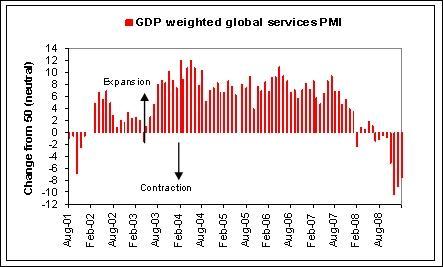
Source: Plexus Asset Management
A snapshot of the week's US economic data is provided below. (Click on the dates to see Northern Trust 's assessment of the various data releases.)
February 20
• CPI report - underlying trend of deflation will fade only later
February 19
• Index of Leading Indicators improved, but wait before taking a leap
• Wholesale prices moved up, but inflation is a non-issue, for now
• Jobless Claims - dismal labor market conditions persist
February 18
• Industrial Production plunges, factory operating rate at record low
• Construction of new homes at new low
• Import prices - sixth consecutive monthly decline
February 17
• Housing Market Index - showing signs of stability?
• Foreign appetite for Treasury securities remains in place for moment
Given the nature of economics reports of recent months, the minutes of the Federal Open Market Committee (FOMC) meeting of January 27-28 come as no surprise. Asha Bangalore ( Northern Trust ) said: “The FOMC is more bearish about the economy compared with the forecast published in October 2008. The US economy is predicted to contract in 2009 (-1.3% to -0.5%) on a Q4-to-Q4 basis.
“The consensus forecast among the Blue Chip Survey participants is a 1.9% drop in real GDP on an annual average basis in 2009. We are predicting a 2.7% decline in real GDP … So, there is a general expectation of a significant weakening of business conditions during 2009.”
Week's economic reports
Click here for the week's economy in pictures, courtesy of Jake of EconomPic Data .
| Date | Time (ET) | Statistic | For | Actual | Briefing Forecast | Market Expects | Prior |
| Feb 17 | 8:30 AM | Empire State Mfg. | Feb | -34.65 | -24.0 | -23.75 | -22.2 |
| Feb 17 | 9:00 AM | Net Long-Term TIC Flows | Dec | $34.8B | NA | $20.0B | -$25.6B |
| Feb 18 | 8:30 AM | Housing Starts | Jan | 466K | 525K | 529K | 560K |
| Feb 18 | 8:30 AM | Building Permits | Jan | 521K | 520K | 525K | 547K |
| Feb 18 | 8:30 AM | Export Prices ex-agriculture | Jan | 0.0% | NA | NA | -1.9% |
| Feb 18 | 8:30 AM | Import Prices ex-oil | Jan | -0.8% | NA | NA | -1.1% |
| Feb 18 | 9:15 AM | Industrial Production | Jan | -1.8% | -1.5% | -1.5% | -2.4% |
| Feb 18 | 9:15 AM | Capacity Utilization | Jan | 72.0% | 72.4% | 72.4% | 73.3% |
| Feb 18 | 2:00 PM | FOMC Minutes | Jan. 28 | - | NA | NA | NA |
| Feb 19 | 8:30 AM | Core PPI | Jan | 0.4% | 0.1% | 0.1% | 0.2% |
| Feb 19 | 8:30 AM | PPI | Jan | 0.8% | 0.2% | 0.3% | -1.9% |
| Feb 19 | 8:30 AM | Initial Claims | 02/14 | 627K | 620K | 620K | 627K |
| Feb 19 | 10:00 AM | Leading Indicators | Jan | 0.4% | NA | 0.1% | 0.2% |
| Feb 19 | 10:00 AM | Philadelphia Fed | Feb | -41.3 | -26.0 | -25.0 | -24.3 |
| Feb 19 | 11:00 AM | Crude Inventories | 2/13 | -138K | NA | NA | 4.72M |
| Feb 20 | 8:30 AM | Core CPI | Jan | 0.2% | 0.0% | 0.1% | 0.0% |
| Feb 20 | 8:30 AM | CPI | Jan | 0.3% | 0.2% | 0.3% | -0.8% |
Source: Yahoo Finance , February 20, 2009.
In addition to Fed Chairman Bernanke's semi-annual testimony on monetary policy before the US Senate Banking Committee (Tuesday, February 24), the US economic highlights for the week include the following:
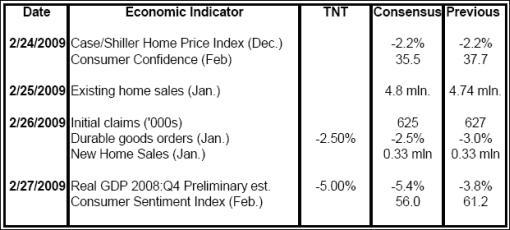
Source: Northern Trust
Click here for a summary of Wachovia's weekly economic and financial commentary.
Markets
The performance chart obtained from the Wall Street Journal Online shows how different global markets performed during the past week.
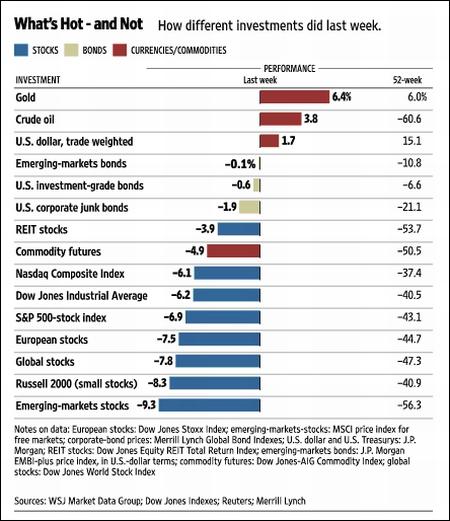
Source: Wall Street Journal Online , February 20, 2009.
“Analysts can tell you everything about the ship, the crew, the price - but they don't let you know whether it's in shallow water or is about to be hit by a tidal wave,” said Scott Cleland (hat tip: Charles Kirk ). Hopefully the “Words from the Wise” reviews play a part in steering the portfolios of Investment Postcards ‘ readers through the murky waters.
That's the way it looks from Cape Town.
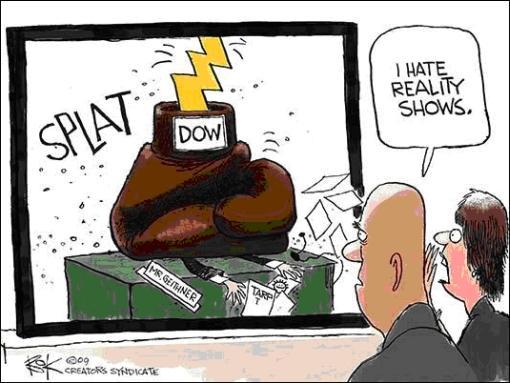
Bloomberg: Obama unveils $275 billion plan to shore up housing
“US President Barack Obama pledged $275 billion to cut mortgage payments for as many as 9 million struggling homeowners and enable Fannie Mae and Freddie Mac to keep loan rates down.
“The plan includes $75 billion to reduce monthly payments for borrowers, helps homeowners with loans owned or backed by Fannie Mae and Freddie Mac to refinance at lower rates and promises incentives to industry. Obama will double by $200 billion funding available for Fannie and Freddie to buy loans.
“‘It will give millions of families resigned to financial ruin a chance to rebuild,' Obama said today in Mesa, Arizona. ‘By bringing down the foreclosure rate, it will help to shore up housing prices for everyone.'
“The program signals the Obama administration, which will release more details in two weeks, plans a more active stance to halt foreclosures than the Bush administration, which backed voluntary industry efforts. Record foreclosures in the past year are swelling the glut of properties on the market, forcing down home values and undermining homebuilders' efforts to revive demand and lighten inventory by cutting prices.
“‘We tried voluntary, it didn't work,' Federal Deposit Insurance Corp. Chairman Sheila Bair said today at a briefing in Mesa before Obama spoke. Bair has pressed the banking industry to accelerate loan modifications to keep people in their homes.
“JPMorgan Chase & Co. Chief Executive Officer Jamie Dimon said the Obama plan will help the bank expand its modification of mortgages. ‘The plan is good and strong, comprehensive and thoughtful,' Dimon said in an interview today. ‘I think it will be successful in modifying mortgages in a way that's good for homeowners.'”
Source: Alison Vekshin and Roger Runningen, Bloomberg , February 18, 2009.
CNBC: Santelli's “rant of the year”
“CNBC's Rick Santelli and the traders on the floor of the CME Group express outrage over the notion they may have to pay their neighbor's mortgage, particularly if they bought far more house than they could actually afford, with Jason Roney, Sharmac Capital.”
Source: CNBC , February 19, 2009.
CNN: FDIC's Bair speaks out on housing
Source: CNN , February 20, 2009.
Bill King (The King Report): Why have banks not been nationalized?
“There is a major reason why banks have not been nationalized. Too many solons and insiders will lose their equity and stock options. There will be no structural revival until crony capitalism ends.
“Here is a major reason why a bank bailout plan cannot be orchestrated: Banks do not, because they cannot, reveal the amount and magnitude of their toxic paper. We said this in October before TARP and we will reiterate again. The market cannot withstand full disclosure of crappy paper.”
Source: Bill King, The King Report , February 17, 2008.
Bloomberg: Shiller says US needs long-term plan to exit crisis
“Robert Shiller, chief economist at MacroMarkets LLC and an economics professor at Yale University, talks with Bloomberg's Kathleen Hays about the need for a long-term US strategy to emerge from the financial crisis. Shiller also discusses the US's efforts to stem the crisis and the outlook for the housing market.”
Source: Bloomberg , February 20, 2009.
Financial Times: US carmakers to seek $21.6 billion in funds
“General Motors and Chrysler presented long-awaited plans to return to viability on Tuesday, but said they would need up to $21.6 billion more in federal funds between them to carry them out.
“The two Detroit carmakers made the plea as part of tougher new plans to restructure and downsize their businesses in submissions to the government required as a condition of the $17.4 billion of emergency bridge loans they received in December.
“Their request for more funds reflects more pessimistic assumptions about global demand for cars and credit market conditions than Chrysler and GM presented to Congress on December 2.
“It raises the ante for President Barack Obama's administration as it juggles demands for federal aid from banks and other constituencies and prepares to implement its $787 billion stimulus bill.”
Source: John Reed, Bernard Simon and Andrew Ward, Financial Times , February 18, 2009.
Ifo: Indicator for the World Economic Climate falls further
“The Ifo World Economic Climate has worsened further in the first quarter of 2009. The indicator has fallen to a new historic low. The decline is solely the result of more unfavourable assessments of the current economic situation; the expectations for the coming six months have improved somewhat.
“The deterioration of the Ifo World Economic Climate has affected all major economic regions. The export and import expectations of the WES experts indicate a clear decline in world trade in the first half of 2009.
“Average inflation expectations for 2009 are clearly lower than the inflation rates of the previous year (3.3% versus 5.4%). Moreover, price increases will continue to weaken in the course of the next six months in the opinion of the WES experts. The decline in inflation will be particularly strong in Western Europe and North America.
“In light of the recessionary tendencies and the clear slowing of price increases, a further decline in central bank interest rates is expected nearly everywhere. Also long-term interest rates are expected to fall in the coming six months, according to the WES experts, albeit less than short-term interest rates.
“After the strong increase in value of the Japanese yen, for the first time since 2002 it is no longer regarded as undervalued but now as slightly overvalued. On the other hand, after the clear weakening in past months the British pound is now viewed as undervalued. The US dollar is largely seen as properly valued, and correspondingly, WES experts anticipate a stable dollar in the coming six months.”
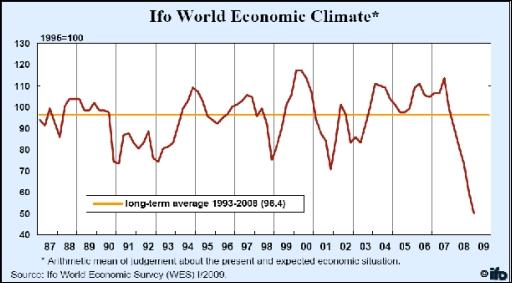
Source: Ifo , February 18, 2009.
BCA Research: Financial crises and public finances - where is the greatest risk?
“Our fixed income team has just published a Special Report comparing 22 developed government debt in the face of the current financial crisis.
“The Special Report reviewed the vulnerability of these markets to rating downgrades as well as focused on the risks and potential costs associated with stabilizing their banking systems (after analyzing 150 banks around the world). A further loss of as little as 3% on total bank assets would wipe out most, if not all, of the remaining tangible bank capital in the countries we analyzed.
“UK, Ireland, Denmark and Switzerland have the greatest risk of widespread nationalization (outside of Iceland). When the other main factors that determine overall sovereign credit risk are included (e.g. economic structure and prospects, monetary flexibility, fiscal flexibility, and external liquidity dependence) Iceland, Portugal, Ireland, Spain, Italy and the UK are at the top in terms of the risk of downgrades.
“The cost of cleaning up the US banking system will also be painful, although the risk of a sovereign downgrade is less than in most of the other developed countries.”
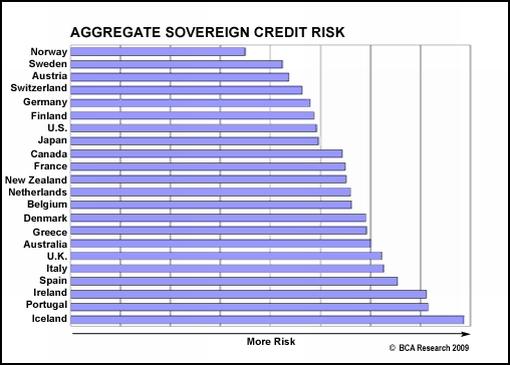
Source: BCA Research , February 18, 2009.
Word Net Daily: Federal obligations exceed world GDP
“As the Obama administration pushes through Congress its $800 billion deficit-spending economic stimulus plan, the American public is largely unaware that the true deficit of the federal government already is measured in trillions of dollars, and in fact its $65.5 trillion in total obligations exceeds the gross domestic product of the world.
“The total US obligations, including Social Security and Medicare benefits to be paid in the future, effectively have placed the US government in bankruptcy, even before new continuing social welfare obligation embedded in the massive spending plan are taken into account.
“The real 2008 federal budget deficit was $5.1 trillion, not the $455 billion previously reported by the Congressional Budget Office, according to the ‘2008 Financial Report of the United States Government' as released by the US Department of Treasury.
“The difference between the $455 billion ‘official' budget deficit numbers and the $5.1 trillion budget deficit cited by ‘2008 Financial Report of the United States Government' is that the official budget deficit is calculated on a cash basis, where all tax receipts, including Social Security tax receipts, are used to pay government liabilities as they occur.
“But the numbers in the 2008 report are calculated on a GAAP basis (‘Generally Accepted Accounting Practices') that include year-for-year changes in the net present value of unfunded liabilities in social insurance programs such as Social Security and Medicare.
“Under cash accounting, the government makes no provision for future Social Security and Medicare benefits in the year in which those benefits accrue.”
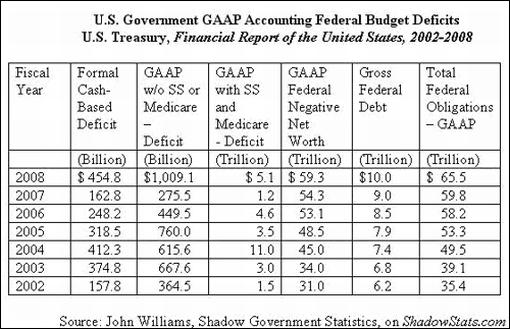
Source: Jerome Corsi, World Net Daily , February 13, 2009.
Bloomberg: Roubini says Europe's banking system faces growing risks
“Nouriel Roubini, the New York University economist who predicted the global financial crisis, talks with Bloomberg's Erik Schatzker and Julie Hyman about the growing risks facing Europe's banking system. Roubini also discusses the outlook for a ‘massive' increase in the US deficit, the need to nationalize insolvent banks and the importance of global cooperation in financial regulation.”
Source: Bloomberg , February 20, 2009.
Asha Bangalore (Northern Trust): Minutes of January FOMC meeting
“The FOMC is more bearish about the economy compared with the forecast published in October 2008. The US economy is predicted to contract in 2009 (-1.3% to -0.5%) on a Q4-to-Q4 basis. The unemployment rate is predicted to advance higher than previously predicted and the inflation is expected to hold below the level seen in the October forecast.
“The direction of revisions to the Fed's projections is not a surprise given the nature of the economic reports of recent months. The consensus forecast among the Blue Chip Survey participants is a 1.9% drop in real GDP on an annual average basis in 2009. We are predicting a 2.7% decline in real GDP on an annual average basis during 2009. So, there is a general expectation of a significant weakening of business conditions during 2009.”
Source: Asha Bangalore, Northern Trust - Daily Global Commentary , February 18, 2009.
Asha Bangalore (Northern Trust): Index of Leading Indicators advances in January, but wait before taking a leap
“The Index of Leading Economic Indicators (LEI) increased 0.4% in January after a revised 0.2% gain in December, previously reported as a 0.3% increase. The index of LEI has moved up for two straight months. Historically, the LEI has been a reliable indicator warning about turning points of the economy ahead of other economic indicators.
“The two consecutive monthly gains of the index have to be interpreted with caution. Inflation adjusted money supply has made hefty positive contributions for five straight months and the interest rate spread is another component that has been an advancing component for several months. Both of these components have risen for reasons that do not reflect bullish economic conditions. Inflation adjusted money supply is advancing because currency, demand and saving deposits have risen sharply. At the same time, bank lending has contracted. The two signals are inconsistent and they do not denote the underlying conditions that suggest a revival of economic activity.”
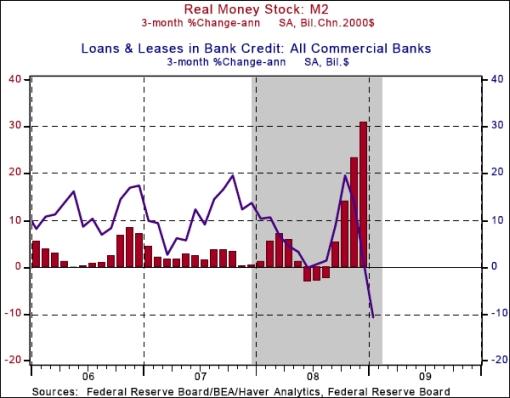
Source: Asha Bangalore, Northern Trust - Daily Global Commentary , February 19, 2009.
Asha Bangalore (Northern Trust): Industrial production plunges
“Industrial production fell 1.8% in January, following a downwardly revised 2.4% drop in the prior month. If utilities production had not advanced at a rapid clip of 2.7%, the headline would have been weaker. The 23.4% decline in auto production from extended shutdowns of auto plants subtracted more than one percentage-point from the change in industrial production. Manufacturing output fell 2.5% in January; excluding autos, factory production dropped 1.4%, which is indicative of widespread weakness in the factory sector.
“On a year-to-year basis, factory production fell 12.9% and excluding autos it declined 10.8% in January.”
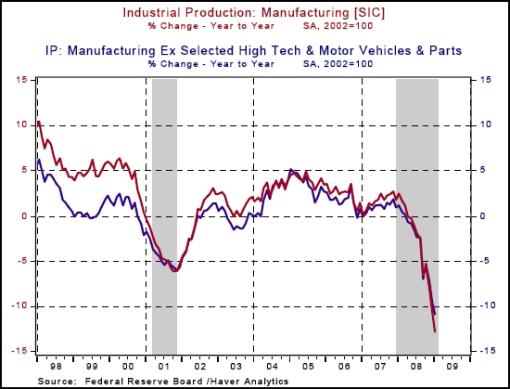
Source: Asha Bangalore, Northern Trust - Daily Global Commentary , February 18, 2009.
Asha Bangalore (Northern Trust): Construction of new homes at new record low
“Construction of new homes fell to a record low of 466,000 in January, which is down 79.5% from the peak in January 2006. The 16.8% drop in housing starts during January reflects a 12.2% decline in starts of new single-family homes and a 27.9% decline in starts of multi-family homes.
“The grim news has a positive aspect because in an environment of a rising inventory of unsold new homes (12.9-month supply, record high in December 2008) a reduction in the construction of new homes is necessary to reduce the supply of new homes and bring about stability in the housing market.”
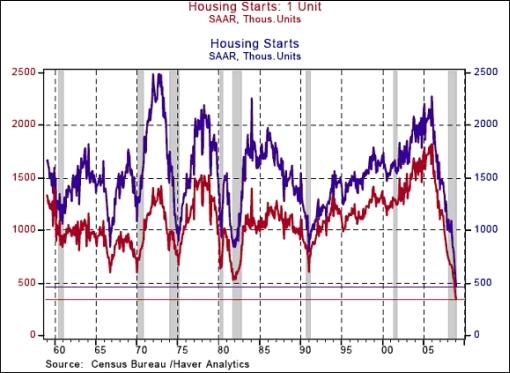
Source: Asha Bangalore, Northern Trust - Daily Global Commentary , February 18, 2009.
Asha Bangalore (Northern Trust): Housing Market Index showing signs of stability?
“The Housing Market Index (HMI) of the National Association of Home Builders inched up to 9.0 in February from 8.0 in January. It is a small but noteworthy improvement because a decline of the same magnitude would be seen in a different light. Also, it is necessary to note that this is a single monthly reading. Additional gains of the index in the months ahead will be necessary to confirm that the housing market has turned the corner.”
Source: Asha Bangalore, Northern Trust - Daily Global Commentary , February 17, 2009.
Asha Bangalore (Northern Trust): Wholesale prices moved up in January, but not problematic
“The Producer Price Index (PPI) for Finished Goods rose 0.8% in January, following a string of five monthly declines. The major culprit was a 3.7% jump of the energy price index which had declined for six consecutive months and a 0.4% increase of the core PPI, which excludes food and energy. The food price index fell 0.4% in January after a 1.4% drop in the prior month. Higher energy prices in February point to another monthly gain of the energy price index.”
Source: Asha Bangalore, Northern Trust - Daily Global Commentary , February 19, 2009.
Asha Bangalore (Northern Trust): January CPI report - underlying trend of deflation will fade only later
“The Consumer Price Index (CPI) rose 0.3% in January, the first increase since July 2008. The CPI is unchanged from a year ago, the lowest reading since August 1955. The core CPI, which excludes food and energy, moved up 0.2% after a steady reading in December. On a year-to-year basis, the core CPI advanced 1.7% in January, the lowest since August 2004. Although these headlines take the edge off concerns about deflation temporarily, the underlying trend of deflation will fade only much later in 2009.”
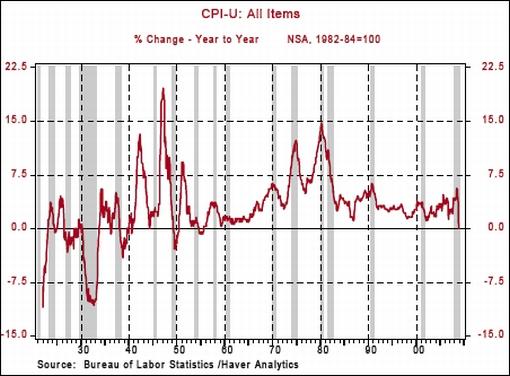
Source: Asha Bangalore, Northern Trust - Daily Global Commentary , February 20, 2009.
Did you enjoy this post? If so, click here to subscribe to updates to Investment Postcards from Cape Town by e-mail.
By Dr Prieur du Plessis
Dr Prieur du Plessis is an investment professional with 25 years' experience in investment research and portfolio management.
More than 1200 of his articles on investment-related topics have been published in various regular newspaper, journal and Internet columns (including his blog, Investment Postcards from Cape Town : www.investmentpostcards.com ). He has also published a book, Financial Basics: Investment.
Prieur is chairman and principal shareholder of South African-based Plexus Asset Management , which he founded in 1995. The group conducts investment management, investment consulting, private equity and real estate activities in South Africa and other African countries.
Plexus is the South African partner of John Mauldin , Dallas-based author of the popular Thoughts from the Frontline newsletter, and also has an exclusive licensing agreement with California-based Research Affiliates for managing and distributing its enhanced Fundamental Index™ methodology in the Pan-African area.
Prieur is 53 years old and live with his wife, television producer and presenter Isabel Verwey, and two children in Cape Town , South Africa . His leisure activities include long-distance running, traveling, reading and motor-cycling.
Copyright © 2009 by Prieur du Plessis - All rights reserved.
Disclaimer: The above is a matter of opinion and is not intended as investment advice. Information and analysis above are derived from sources and utilizing methods believed reliable, but we cannot accept responsibility for any trading losses you may incur as a result of this analysis. Do your own due diligence.
Prieur du Plessis Archive |
© 2005-2022 http://www.MarketOracle.co.uk - The Market Oracle is a FREE Daily Financial Markets Analysis & Forecasting online publication.






